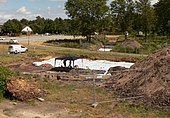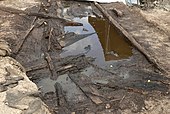Rehburg Castle

The castle Rehburg is built around the 13th century castle in Rehburg , in what is now Lower Saxony . It was a stronghold of the Guelphs against the Counts of Hoya , as well as against the Counts of Schaumburg and the Bishop of Minden . In the 18th century, a half-timbered building was built on the foundation walls of the castle, which housed an administrative courtyard and later a forestry office . Today the buildings with extensions from the 1980s serve the town of Rehburg-Loccum as town hall .
location
The Rehburg is located on an elevation in the lowlands of the Steinhuder Meerbach , about three kilometers west of the Steinhuder Meer . At this point a nationally important traffic route once ran on a stick embankment through the wetland of the Meerbruch , which could be controlled here at the intersection with the Meerbach.
The Rehburg settlement developed near the castle along the Knüppeldamm, which was called Weichbild in the 15th century . About three kilometers to the west are the remains of the early medieval ring wall system Düsselburg from the 8th to 10th centuries, which served the population as a refuge .

history
Timbers of a stick dam found in Rehburg, which could be dated to the year 1260, suggest that the Rehburg was built in the middle of the 13th century. It was first mentioned in 1320, when Count Adolf VII. Von Schaumburg and Duke Otto II. Von Braunschweig-Lüneburg concluded a union against the Minden monastery in a document . The Rehburg built on the property of Loccum Monastery protected the County of Wölpe . In 1331, Count Adolf VII von Schaumburg acquired the property with a monetary payment, as well as the assurance of duty exemption and the payment of tithes on land in Ricklingen near Hanover.
In the 14th century, the von Mandelsloh family received the castle from the dukes of Braunschweig and Lüneburg as a pledge. In 1371 Duke Magnus II. Torquatus gave the castle to the Count of Hoya as a pledge. From the year 1387 the von Münchhausen owners were pawnbrokers, to whom the castle still served as a widow's residence in 1577 . From 1586 it fell back to the dukes of Braunschweig and Lüneburg.
Building description
The castle complex, which was handed down historically as Reheburgk , was a two-wing complex . It had an outer bailey with buildings. The castle and outer bailey were surrounded by a moat fed by the Steinhuder Meerbach flowing past. Written records from the years 1577 and 1586 list the castle buildings. A bower with a hall, a beer and wine cellar, a brewery, a gate house, a wind and a watermill, a courtyard room and a writing room are mentioned.
In 1754 a half-timbered building was built on the foundation walls of the castle, which served as an official and later as a forester's house. The front of the building in the classicist style has been plastered, while the back consists of exposed half-timbering. A side and a rear annex were also built in half-timbered construction. The building complex has served as the municipal administrative center since 1969, initially for the municipality of Rehburg and, after the regional reform of 1974, as the town hall of Rehburg-Loccum. In the 1980s there were extensions in historicizing forms.
Finds
Over time, redesigns have changed the moats of the castle grounds and the area of the outer bailey. A local researcher collected finds from the 14th to 17th centuries on the castle grounds. Century that were found on the surface of the earth. These include ceramic shards and metal parts such as a dagger , a dagger sheath, a pot helmet and a powder horn . You are in the Rehburg local history museum.
Excavations
In 2017, an excavation company carried out an excavation west of the Rehburg on an area that was intended for urban redesign. Earlier building structures were found there over a width of up to five meters and a length of 50 meters. They included oak stakes stuck in the boggy ground. According to dendrochronological studies on over 280 woods, the piles date from around 1300 to 1600. The oldest piles were set in 1259, before Rehburg was first mentioned in 1320. The archaeologists suspect that the piles belonged to a barrier or fortification which was maintained for over 300 years and which already existed before the foundation of the castle and town of Rehburg. The state of Lower Saxony funded the evaluation and presentation of the found material as a project of the European Year of Cultural Heritage 2018.
In 2019, an excavation company carried out excavations east of the Rehburg on an area on which new buildings are planned. During this process, wooden structures were uncovered in the ground which, according to dendrochronological studies, date from around 880 AD. These include planks that could have served as a support surface for a wall and wooden sticks as the remains of a bank reinforcement on the Meerbach, which then had a different course. The wood has been preserved in the moist soil due to the favorable conservation conditions for organic material .
literature
- Hans-Wilhelm Heine : Schaumburger Land - Burgenland , in the series: Guide to the prehistory and early history of Lower Saxony . (29), Oldenburg 2010, published by the Lower Saxony State Office for Monument Preservation and the Archaeological Commission for Lower Saxony , ISBN 978-3-89995-673-3
- Jens Berthold : Piles in Rehburg and how to build on wood in Schaumburg and Nienburg in Archeology in Lower Saxony , 2018, pp. 128-131
- Jens Berthold: Reborgh - Reheburgk - Rehburg. Archeology and early history (= writings of communal archeology in the Schaumburg landscape. 5). Municipal archeology Schaumburger Landschaft, Bückeburg, 2018.
Web links
- Entry by Stefan Eismann zu Rehburg in the scientific database " EBIDAT " of the European Castle Institute
- Historical reconstruction drawing
Individual evidence
- ↑ Rewrite local history in Stadtgeschichten Rehburg-Loccum from March 2017
- ↑ Rehburg is older than expected in Schaumburger Nachrichten of July 23, 2018
- ↑ Beate Ney-Janßen: Settlement remains discovered: Rehburg is older than expected in the Schaumburger Nachrichten of June 25, 2019
Coordinates: 52 ° 28 '26.1 " N , 9 ° 13' 44.1" E





